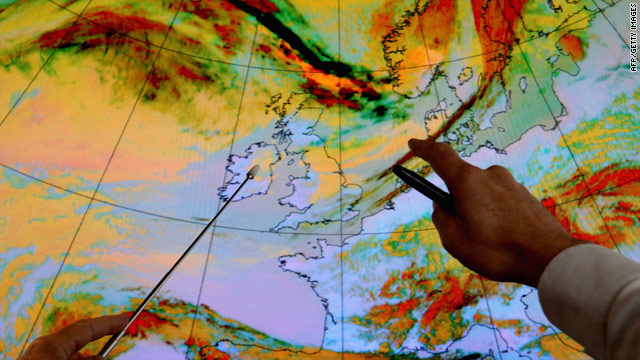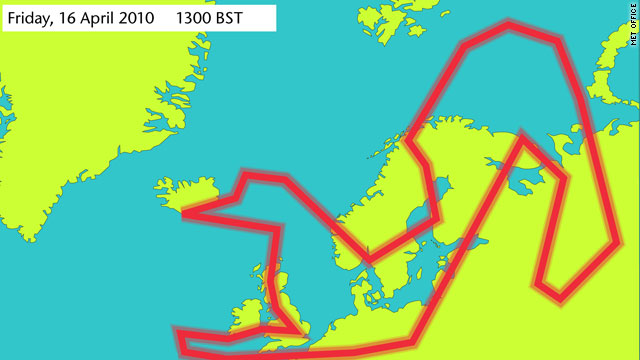Experts: No end to volcano ash in sight

(CNN) -- Weather experts predicted Friday that a volcanic ash causing chaos to air traffic across Europe would affect the region well into the weekend and possibly beyond as the dust cloud continued to spread.
Scientists said it was too soon to predict when the Eyjafjallajökull volcano in Iceland would cease spewing ash, raising the prospect of thousands more grounded flights in coming days.
Prevailing westerly winds are expected to fan the massive plume of dust from an erupting volcano in Iceland further east and north, according to predictions from the London Ash Advisory Center.
By 07:00 GMT Saturday (7 p.m. ET) the cloud traveling at up to 9,000 meters (30,000 feet) is forecast to be covering parts of Russia, Poland, Finland and other East European countries while continuing to affect the UK, Sweden, Norway, Germany, Denmark and Netherlands.
Volcanic ash still causing travel chaos
Northern parts of Sweden, the UK, and Ireland, which have begun to reinstate air flights, would remain in the clear for the time being, according to forecasts.
CNN meteorologist Brandon Miller said upper-level winds will remain largely from the same direction, from the North and West, over the next 40 hours, bringing ash from the volcano into northern Europe.
"We expect the speed of the winds to decrease over Iceland and the North Sea, however, which could limit the distance the plume will travel, as well as limit the concentration of the ash if and when it reaches mainland Europe," he said.
He said if the volcano in Iceland volcano continues to spew ash at the same rate, disruption would continue. If the ash ejections lessen combined with weakening winds, conditions could improve through the weekend
 Video: Weekend airspace issues
Video: Weekend airspace issues  Video: Life in the land of ice & ash
Video: Life in the land of ice & ash  Gallery: Ash cloud forecast
Gallery: Ash cloud forecast The UK's Met Office said Eyjafjallajökull was now releasing ash in "pulses" rather than a steady plume, but scientists say it is too early to predict how long the eruption would last. The volcano's last major eruption in 1821 lasted for two years.
Professor Peter Sammonds of University College London's geophysics department said it would be possible to determine the expected duration of the eruption once data is gathered, although conditions around the volcano were currently hampering this.
iReport: Have your plans been disrupted? Send images, videos
"The reason it's going through quite a fierce phase at the moment is because ice is melting and water is mixing with magma causing it to fragment," he told CNN.
"This will go on until the water supply runs out, which could be quite some time."
Although the Ash Advisory Center models cloud movements for up to 10 days ahead, it was restricting its public forecasts to the next 24 hours, so it was unclear what areas the dust would be affected into Sunday and the following week.
Although the ash cloud -- made up of tiny particles of volcanic matter held in suspension -- is moving relatively high in the atmosphere, meteorologists said there were signs some dust was settling at lower levels.
The Met Office said it had received recordings of dust in the air at Lerwick in Scotland and in Bedfordshire, northeast of London. There were also reports of dust settling on parked vehicles in some parts of the UK, it said.
CNN's Miller says, with no major storm system on the horizon, the prevailing winds would continue to dictate movement.
"The volcanic ash is transported primarily by upper-level winds," Miller said. "Once the ash is ejected into the atmosphere by the volcano, the only real forces acting on it are gravity and wind."
Travelers rush to trains and ferries
"This fine volcanic ash can rise extremely high in the atmosphere, up to 50,000 feet, where planes cannot fly over them," Miller said. "At this height, the winds can be very strong and can therefore transport the plume of fine ash several hundred miles."
Miller said the dispersion of the cloud will make it less dangerous as it travels. It's very unlikely that United States skies would be affected, but northern Europe may not be out of the dark soon.
"The other problem is that the volcano is still erupting and still transmitting the ash into the atmosphere," Miller said. "As long as the volcano is erupting, the ash will continue being transported by the wind, and flight disruption will continue."
Craig Johnson and CNN's Barry Neild contributed to this report.


No comments:
Post a Comment